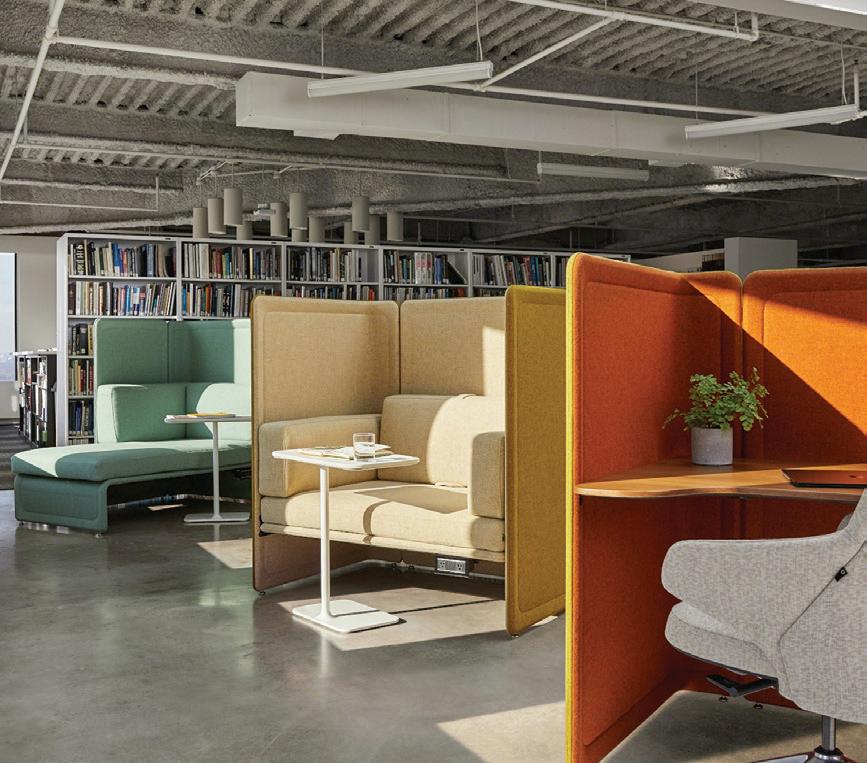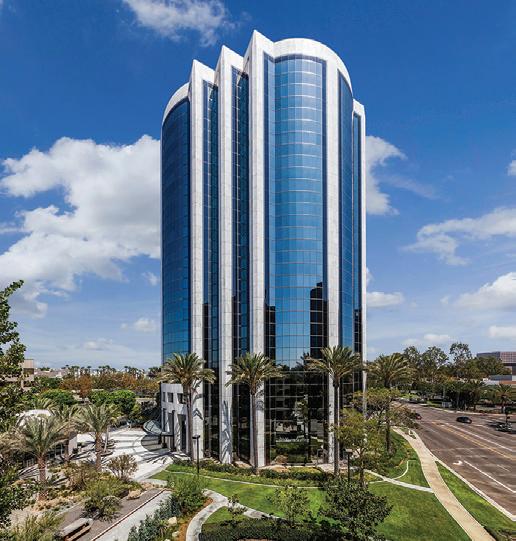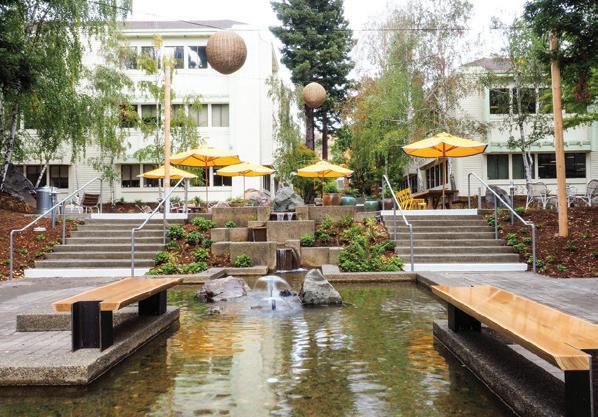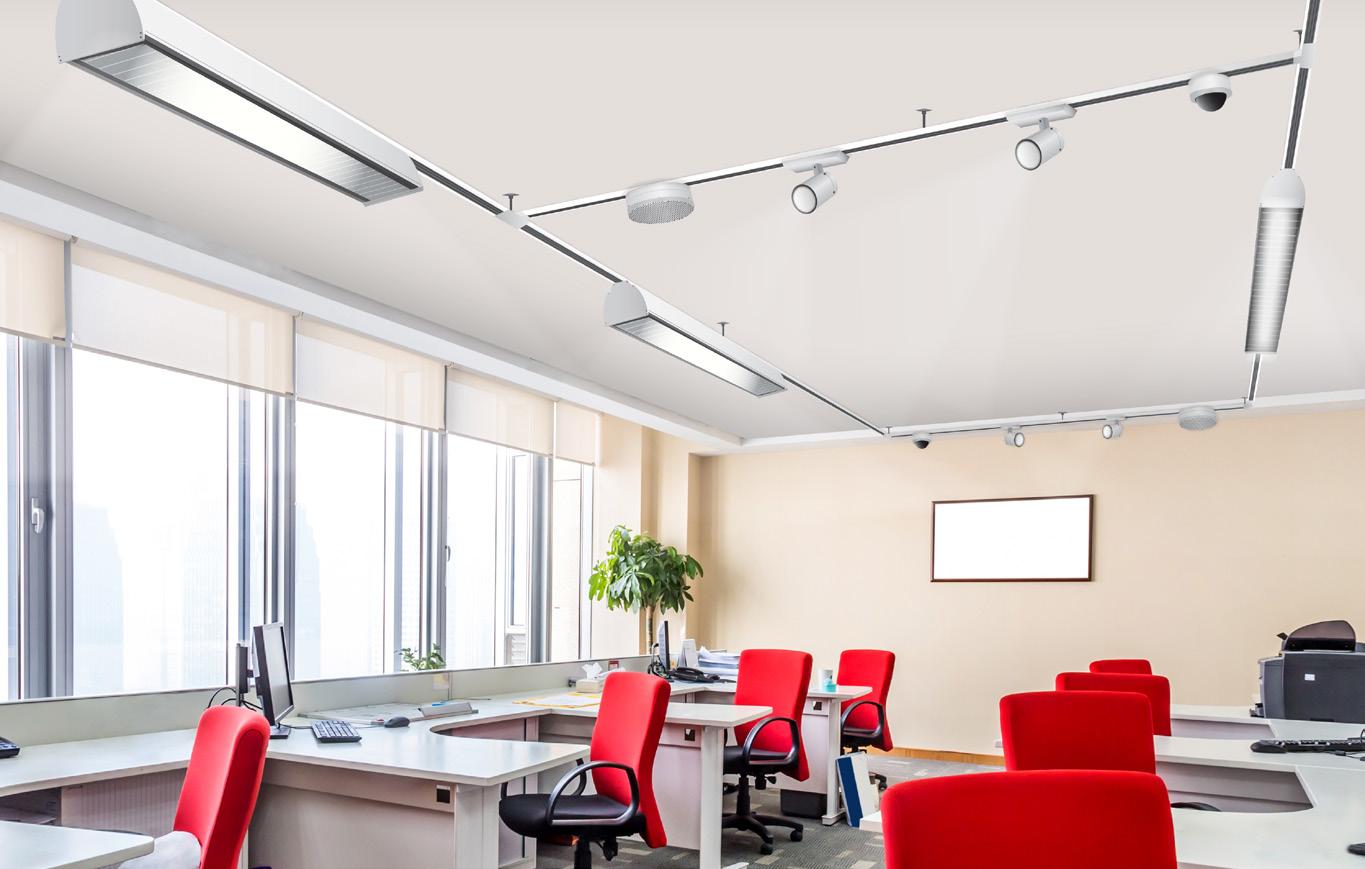
20 minute read
Opening Up: Workplace Strategies
California Buildings News • Q2 2021
OPENING UP!
Post-Pandemic Workplace Designs and Strategies
Above: The JLL Orange County office in Irvine, California, was designed by H. Hendy Associates with the aim of promoting cross-collaboration. Photo courtesy of H. Hendy Associates.
How many of us will return to our workplaces? If so, how do we get there? How many days a week are necessary? Will others there make us sick by not wearing masks? Must we be vaccinated? How long will we have to wait in line to use an elevator in a skyscraper...to go to lunch...to go home? How productive and happy have we been working from home? Do we need to mix with people to do a better job and advance in the office politics game? And, what will our workplaces look like when we get there? Will our workplaces be better? A lot of questions...and a lot of answers.
Many California building managers say most tenants are not investing in wholesale changes in the design of their workplaces, preferring a wait-and-see posture to see exactly how workplaces will be used in the new hybrid use world. Some forward thinkers are imagining what that will be. Meantime, many manufacturers are creating products designed to make workplaces safer by improving air quality, elevator operation, sensoring for space use.
According to a study sponsored by the Building Owners and Managers Association, “61% of all respondents report they will reassess their space needs with 43% seeking to reduce the size of their office square footage, 24% maintaining their current footprint, 9% increasing their size and the remainder being unsure.”
Henry H. Chamberlain, BOMA’s president, said, “While study results indicate high probabilities around changes in size, use and design of office space going forward, we have also seen a significant rebound in the utility of physical work environments since the onset of the pandemic, with 74% of all study respondents affirming that in-person offices are operationally vital to their businesses, long-term growth and future success.”

The Wall Street Journal reports recently that scores of managers in all types of companies are leaning toward needing workers to be physically present—at least some of the time—in order to stay more engaged in corporate goals.
Kelly Dubisar, a design director at Gensler in San Francisco, says, “Before COVID-19, many companies were already imagining the future of their workplace, what it might look like, and how it could accommodate the evolving ways we spend our workdays.
“Now, more than a year into the pandemic, these conversations have gone from conceptual to critical. Companies who previously subscribed to a nine-to-five, one desk/one-person approach are now suddenly inspired to reevaluate their whole way of working. Many are embracing a hybrid work model, in which employees split their time between in-office and remote work.
“As such, the one-size-fits-all workplace is finally a thing of the past; the office of the future will be built for adaptability and will be able to morph as behaviors change and attitudes evolve.”
Tenants need to resume occupancy to strategize how to best use their space and design configurations to better manage the flow of employees, Kevin Whalen, president of the Building Owners and Managers Association of San Francisco, wrote in the latest edition of BOMA Views. The Jones Lang LaSalle executive said BOMA-member owners and managers are helping tenants implement new technologies that improve air quality, reduce contact of high-touch surfaces and upgrade cleaning methods and institute better wellness and health standards.
“So, what will the office’s role be?” asks Dubisar. “It’ll be a place for collaboration, socialization, and connection to purpose, both hyper-collaboration and hyper-focus. It will have furniture that’s easily configurable and supports the latest technology. As a destination, it will be a place that emanates culture, and it will need to offer what the home office cannot. It will need to reconsider protocols and behaviors to ensure the remote employee feels connected when they’re not physically there. And it will need to prioritize wellness through ergonomics and outdoor spaces – not just a picnic table and an umbrella in a courtyard, but a true inside/outside office optimized for getting things done. “The workplace of the future will be a workplace with heart—one that prioritizes people and evolves to meet their needs.”
“The one-size-fits-all workplace is finally a thing of the past; the office of the future will be built for adaptability and will be able to morph as behaviors change and attitudes evolve.” — Kelly Dubisar, Gensler

Business Community Rocked By Change
Heidi Hendy, managing principal of H. Hendy Associates in Newport Beach, says, “Never before in modern history has the business community, and specifically commercial real estate, experienced such profound and dramatic change. The marketplace faced a long, arduous year with unexpected demands on resources and personnel. It was beyond transitional; it’s been transformative, educational and an eye-opening experience for all.
“Over the past year, we’ve witnessed a fundamental change in the role of office. As we quickly transitioned to virtual and digital workspaces, we saw leadership shift their perspective on remote working and physical space. Business leaders also shared concerns over workplace purpose and rightsizing their future office requirements, yet they have
Creative design solutions



Above: Design for a collaborative office from Steelcase. Image courtesy of Steelcase.
Left: Tech-Integrated furnishings from Coalesse's Lagunitas Lounge collection afford flexibility and safe distancing. Photos courtesy of Coalesse.
Opening Up (Continued from page 11)
been awed and inspired by the complexity of the single question: “What is the future of work?”
“Now that we have untethered from our in-office cubicles, desks and paperwork there will be no turning back to the old ways of working. Remote work is here to stay, and recent data implies that it will only continue to accelerate. The overnight transition to remote work also caused a sudden implementation of often underutilized tools. The result: we now have an experienced, digital savvy workforce with the tools to make remote work successful. So, what’s next for office and how do organizations apply learning lessons? Enter the New Generation Space.
“The New Generation Space is a purpose-built environment that drives employee engagement. This hybrid office model also known as a “Hive” is the place people return to for human connection and supports the activities an individual does not or cannot do from home. And although it’s not one-size-fits-all, there’s an emphasis on the following: leadership, cultural experience, in-office employees, collaboration and innovation and agile workspaces. With wellplanned migration patterns and deliberate touchpoints, this hybrid workspace becomes a memorable experience and physical manifestation of a company’s brand promise, culture and values. An environment that supports long-term business goals and inspiring place where people want to work now that they have a choice.
“During the COVID-19 pandemic, Hendy earned the trust of JLL Orange County to apply some of this thinking to the design of their new office in Irvine, California. Completed in 2020, JLL’s new office aims to promote cross-collaboration and is inspired by the firm’s company culture—a place where people want to work and be. Hendy helped the CRE giant bring forth a design that can stand the test of time, is purpose-driven and supports its business strategy. The new JLL office in Irvine, California aims to foster teamwork and collaboration and serve as a model for the future of office. JLL is one of the early adopters of this workplace transformation, and its new space is designed to be a best-in-class example for companies reevaluating their office layout and design.” (See photo of the JLL Orange County office on page 10.)
Did Your Building Get “Sick” During COVID?
The Centers for Disease Control cautions people returning to workplaces and schools to make certain your building is safe for occupancy. Here is some advice:
4 Evaluate the building and its mechanical and life safety 4 Increase circulation of outdoor air as much as possible systems to determine if the build- by opening windows and doors ing is ready for occupancy. Check if possible and using fans. Do not for hazards associated with pro- open windows and doors if doing longed facility shutdown such so poses a safety or health risk for as mold growth, rodents or pests occupants, including children (e.g., or issues with stagnant water a risk of falling or of breathing systems, and take appropriate outdoor environmental contamiremedial actions. nants such as carbon monoxide, 4 Ensure that ventilation systems molds, or pollens). in your facility operate properly. 4 To minimize the risk of LegionFor building heating, ventilation, naires’ disease and other diseases and air conditioning (HVAC) associated with water, take steps systems that have been shut down to ensure that all water systems or on setback, review new con- and features (e.g., sink faucets, struction startup guidance providCDC recommends increasing the circulation of outdoor drinking fountains, decorative ed in ASHRAE Standard 180-2018, air as much as possible. Photo: Adobe Stock. fountains) and water-using devices Standard Practice for the Inspection (e.g., ice machines, cooling towers) and Maintenance of Commercial Building HVAC Systems. are safe to use after a prolonged facility shutdown.



California Buildings News • Q2 2021
Five California-based building teams are Pacific Southwest regional winners of TOBY (The Outstanding Buildings of the Year) Awards, bestowed by the Building Owners and Managers Association (BOMA). These regional winners now advance to the international competition. International TOBY winners will be announced at the BOMA International conference in Boston in October.

500,000 – 1 million Square Feet 333 Bush Street, San Francisco Management Company: Tishman Speyer Building Manager: Glenn Good 100,000 – 249,999 Square Feet Airport Tower, Irvine Management Company: The Muller Company Building Manager: Suzi Mier Renovated Building Techmart, Santa Clara Management Company: Hudson Pacific Properties Building Manager: LaToya Ross


250,000 – 499,999 Square Feet 100 First Street, San Francisco Management Company: Kilroy Realty Building Manager: Megan Pusateri Suburban Office Park Low-Rise The Exchange at Larkspur Landing, Larkspur Management Company: Lincoln Property Company Building Manager: Danae Outeiro


Photo credits: Airport Tower - Freshpage Images. Others provided by their management companies.
Acoustical Door and Window Wall Unit
NEW!
Highest Acoustical Rating—up to STC 52
Krieger’s Acoustical Door and Window Wall Unit underwent rigorous lab testing—in multiple configurations, testing higher than any other wall unit on the market.
Customizable Configuration
Configured to your exact specifications of size, number and placement of doors and windows. Plus, the construction makes it possible to swap out the doors, panels, transoms, and side lights in case your needs change.
Performance Combinations
The Assembly can be manufactured for multiple performance requirements including bullet resistance, blast resistance, radio frequency shielding or any combination thereof.
All Krieger’s products are designed and manufactured in California
California Buildings News • Q2 2021
Industry Groups Support Members During COVID
Online Activities Keep People Connected, Provide Valuable Guidance
Never in our lives have we been so cruelly isolated from our social and business networks. The pandemic has caused us personal and financial loss, and it has severed us from our vital business family. During this pandemic our associations have become our refuge, our source of essential information and, via technologies like ZOOM, often rewarding connections to other people.
Associations have truly demonstrated their value during the most severe “social distancing” period in history. Their volunteer leaders and professional staffs have worked tirelessly and creatively under difficult conditions and sometimes balky tech to develop programs that have helped get us through this long dark time—and to help prepare us for a different and maybe better future. This article details—and salutes—a few of those efforts in California.
From Trivia Night pitting IREM Orange County against IREM-LA to a virtual murder mystery event at IFMA and IREM Sacramento to virtual tour of a beer garden (and a tasting) sponsored by BOMA San Francisco, building industry associations have been keeping people connected on the light side and providing them will valuable career and operational guidance to get them safely and sanely through the pandemic.
Ben Stapleton, executive director, of the Los Angeles chapter of the US Green Building Council, says “The pandemic actually was the push we needed to improve how we engage our community digitally...and in the process, brought us together, providing human connection during a challenging time. From one online webinar in 2019 to over 190 online events in 2020, we pivoted quickly...and the audience responded, with over 11,000 people attending our online meetings, webinars and trainings.
“We maintained and grew interest in our chapter by launching programs that responded to and anticipated the needs of pandemic and post-pandemic issues, such as Healthy Buildings Alliance on occupant health and a Talent Development portal towards green workforce development— two areas on everyone’s mind right now.
“We moved our annual Municipal Green Building Conference and Expo online, expanded it to two days, increased attendance from 600 to over 1300 globally, and were told that, with it being in August, we presented a solid model for others to follow. As an additional note, we had actually selected the theme of ‘Equity’ in Oct. 2019 as the theme for the conference, which wound up being even more relevant than we ever could have guessed, and the conference (we humbly hope) responded and launched us on a more forward-looking path and discussion around equity and sustainability, both within our team and for our greater community.
“Finally, I think our team—which grew by three hires in the last 6 months—has seen the value in these new initiatives, as well as ones we’ve had but got new life online. And their input on how to adjust our programming and communicate it to new audiences has been both creative, inspiring and invaluable. I’m very grateful for this team through this past year, and excited about 2021 and figuring out how to balance the online and IRL future in all we do.”
Building Owners and Managers Association Oakland
East Bay President Kelly Lynch said, “Despite the challenges the pandemic created, BOMA Oakland/East Bay worked together to continue to build on our strengths—advocacy, education and community engagement.” She listed some of the highlights of activities and events during the past year for members of that very socially engaged group: w Transitioned to virtual learning and created an Online Learning Center for members to access recordings 24/7 w Staff worked with our partners to provide COVID-19 panels on General Contracting, Janitorial, Security, Legal, Building Systems. (April – June)
Your commercial IPM/Green/LEED specialists
Count on Crane for Pest Management Expertise
Serving commercial property managers throughout the Greater Bay Area...since 1930
NPMAGreenPro Certified
California Buildings News • Q2 2021

w “Returning to Work” webinar with BOMA International’s Chairs (April) w Fireside Chats for principals and associates held separately so they could engage and connect about issues that they were facing. (April and July) w Wellness Wednesday Series (September) w Talent Management (October)
BOMA OEB's networking and engagement included using Zoom to connect members for Whiskey Tasting (August), Wine Tasting (September), Virtual Showcase (October), Chopped Board (October), and Charcuterie Building (November). The Annual Meeting moved virtual, with election via electronic vote. The holiday party was held virtually in partnership with BOMA San Francisco.
In addition, BOMA OEB created an online Coronavirus Resource Center to provide members access to the latest information available and sent weekly eblast to keep members informed regarding each counties’ requirements.
Katie Spurlock is marketing director of Salter and a long-time leader of the Society for Marketing Professional Services. SMPS is a group of people who communicate for a living, so you can expect its members met the pandemic with creativity and skill, as they do in marketing architectural, engineering and construction firms day in and day out. Spurlock said, “Shifting to a completely virtual world overnight meant the Society for Marketing Professional Services San Francisco Bay Area Chapter (SMPS SFBAC) had to quickly rethink events and education for its 250 members. Our volunteers embraced the challenge and experimented with multiple virtual platforms to educate themselves and members on best practices for digital engagement.
“Embracing virtual events enabled us to draw on a larger audience for attendance, welcoming and easily accommodating not only members from other chapters, but also co-workers who might not usually attend in-person. This also widened the pool of potential speakers to attract experts from around the country. SMPS SFBAC also shifted its content to address current social issues with programs on diversity, equity, and inclusion (DEI) featuring DEI executives from Sephora and Chevron.
“To address challenges to mental and physical wellbeing, we provide monthly Motivational Mondays to discuss inspiring videos or articles on topics such as how the philosophy of stoicism can lead to peace of mind and clarity during stressful times. We recently held a Wellness Workshop where attendees were treated to meditation, yoga, nutrition tips, and a WELL Certified office TI case study. Striving to best support our members, SMPS SFBAC believes virtual member engagement is here to stay. From the environmental benefits to improving accessibility, creating engaging, high-quality virtual experiences benefits our members and the greater A/E/C community.” n
California Buildings News • Q2 2021
Architectural Billings Continue to Rise

Continuing its meteoric rebound, the Architecture Billings Index (ABI) recorded its third consecutive month of positive billings, according to a new report from The American Institute of Architects (AIA).
AIA’s ABI score for April rose to 57.9 compared to 55.6 in March (any score above 50 indicates an increase in billings). Neither score has been achieved since before the Great Recession. During April, new project inquiries and new design contracts reached record highs with scores of 70.8 and 61.7 respectively.
“This recent acceleration in the demand for design services demonstrates that both consumers and businesses are feeling much more confident about the economic outlook,” said AIA Chief Economist Kermit Baker, Hon. AIA, PhD. “The pent-up demand for new and retrofitted facilities is keeping architecture firms in all regions and building sectors busy.”
Sector index breakdown: commercial/industrial (59.1); multi-family residential (56.9); institutional (56.7); mixed practice (55.0).
Some California Multifamily Sectors Recovering
Revival Fastest in Inland Empire, Sacramento Markets
The multifamily market is rebounding from the pan- Phoenix (8.1%) retained their longstanding positions at the demic at a rapid clip, and gateway markets are now seeing top in April. Gateway markets like New York (-12.6%), positive performance indicators for the first time in many San Jose (-10.8%) and San Francisco (-7.7%) remain at the months. The latest Yardi Matrix Multifamily National bottom, but monthly numbers point to a rebound. Report has much good news for owners and investors, Meantime, CBRE says, “With steadily improving marincluding a 1.6 percent year-over-year ket conditions, multifamily investment rent bump. volume is expected to increase in 2021.
“That is the largest increase that CBRE Research predicts U.S. multifamily we have seen since the beginning of investment volume will reach about $148 the pandemic,” said Matrix analysts. billion next year, lower than 2019’s record Overall rents increased by $10 in level of $191 billion but a 33% gain over April to $1,417. The last time overall the 2020 estimate of $111 billion. rents increased by that amount in a Investor demand for multifamily month was June 2015. It was also assets this year was more than previous the largest year-over-year jump since recessions would have indicated. Pricing March 2020. held up quite well. Still, many investors
Out of the top 30 markets Matrix Luxury apartment complex in Northern moved to the sidelines as the COVID-19 reported on, 24 had month-over- California. Photo: Adobe Stock. pandemic spread. With greater clarity month rent growth greater than 0.5%. on future revenue streams, institutional Of particular significance were the gains in gateway markets. buyers and value-add investors should become much more Miami leads the gateway markets with 0.8% rent growth active next year. Offshore buyers likely will increase their on a trailing 3-month basis. All other gateways had positive activity, especially if travel restrictions are eased. trailing 3-month rent growth, with Chicago (0.5%) and Multifamily segments that had greater market deterioraBoston (0.4%) showing strong gains. Washington, D.C. tion in 2020—such as Class A assets in urban submarkets, (0.2%), New York, San Francisco and Seattle (all 0.1%) are particularly in gateway cities—may not stabilize until well further back in the recovery process. into 2021 and present more investment risk. Buyers may
National rents increased by 1.6% in April on a year- seek pricing discounts for such assets, but significantly disover-year basis—a huge jump from the 0.6% gain in March. counted pricing will remain difficult to find. Every major metro continues to show improvement on a The most impacted metros in 2020 were San Francisco, year-over-year basis, and 21 out of our top 30 metros had San Jose and New York. Other underperformers includpositive YoY rent growth this month. ed Los Angeles, Boston, Seattle, Oakland, Austin, Miami,
The Inland Empire (9.4%), Sacramento (8.4%) and Chicago, Washington, D.C. and Orlando.

California Buildings News • Q2 2021
West Coast Outstrips the East in Tall Building Construction
In the 1st quarter of 2021, more than 120 construc- has seen an increase in its cranes, erected at new infill housing tion cranes swung over rising buildings from Seattle to Los towers in the Downtown, Koreatown, East Hollywood, and Angeles compared to over 68 over major metros along Culver City areas. Multiple mixed-use and commercial projthe East Coast, according to Rider Levett Bucknall’s Crane ects are nearing completion in Culver City and Century City, Index® for North America which is pub- and several hotels in Downtown and Midlished biannually. It tracks the number of Wilshire are slated to open later this year. operating tower cranes in 14 major cities Delayed due to the COVID-19 pandemic, across the U.S. and Canada. the Academy Museum of Motion Pictures is
According to RLB, the survey shows scheduled to open in September 2021. “an increase of cranes from our previous RLB continues, “A dip in the San count; with the count increasing by 71 Francisco crane count reflects the complecranes (overall). Of the 14 cities surveyed: tion of several apartment and condominiseven experienced an increase; four are um projects along the Market Street and holding steady; and three saw significant Van Ness corridors, and infill projects in the decreases, ranging from -44% to -54%. Crane rises above a construction site in South of Market neighborhood. A COVIDThe crane count appears to have rebounded Silicon Valley. Photo: Adobe Stock. induced decrease in occupancy rates for from its previous dip, exceeding its count residential, office, restaurants, and retail from this time last year. We have seen tower cranes installed buildings has depressed new starts; however, this low occuat residential and mixed-use projects increase to 69% of pancy has also likely added efficiencies to projects requiring the overall count. The commercial sector has also seen an tower cranes, offering increased opportunities to operate in aggressive increase since our previous count.” public right-of-way areas during normally peak traffic hours.
Los Angeles metro tied Seattle Metro with 43 cranes Upcoming projects are a mix of residential, institutional each for the most activity along the West Coast, with (including student housing and administration buildings), San Francisco at 10 cranes. The report says, “Los Angeles and mixed-use commercial office buildings.”

Power & Lighting All-In-One

Starline’s revolutionary overhead Track Busway system is flexible enough to power your office equipment and your lighting. To learn more about how Starline Track Busway’s open-access, reconfigurable capabilities make it ideal for open office environments, please visit StarlineBuildings.com/CABN.






